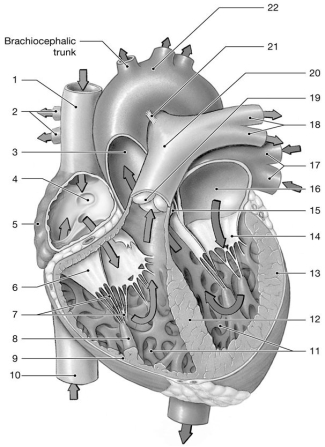A) 1,000
B) 10,000
C) 100,000
D) 1,000,000
E) 10,000,000
Correct Answer

verified
Correct Answer
verified
Multiple Choice
Excess fluid in the ________ causes cardiac tamponade.
A) pericardial cavity
B) visceral pericardium
C) apex of heart
D) left ventricle
E) both atria
Correct Answer

verified
Correct Answer
verified
Multiple Choice
The coronary sinus drains the ________ into the ________.
A) coronary arteries; left ventricle
B) cardiac veins; right atrium
C) interventricular artery; left ventricle
D) right atrium; right ventricle
E) cardiac vein; right ventricle
Correct Answer

verified
Correct Answer
verified
Multiple Choice
The inferior point of the heart is called the
A) apex.
B) hilum.
C) base.
D) septum.
E) mediastinum.
Correct Answer

verified
Correct Answer
verified
Multiple Choice
The T wave on an ECG tracing represents
A) atrial depolarization.
B) atrial repolarization.
C) ventricular depolarization.
D) ventricular repolarization.
E) ventricular contraction.
Correct Answer

verified
Correct Answer
verified
Multiple Choice
The ________ is the amount of blood in a ventricle after it has contracted and before it begins to refill.
A) ejection fraction
B) end-diastole volume
C) start-diastolic volume
D) end-systolic volume
E) stroke volume
Correct Answer

verified
Correct Answer
verified
Multiple Choice
The structure that permits blood flow from the right atrium to the left atrium in the fetal circulation is the
A) foramen ovale.
B) interatrial septum.
C) coronary sinus.
D) fossa ovalis.
E) ligamentum arteriosus.
Correct Answer

verified
Correct Answer
verified
Multiple Choice
The earlike extension of the atrium is the
A) ventricle.
B) coronary sinus.
C) coronary sulcus.
D) auricle.
E) atricle.
Correct Answer

verified
Correct Answer
verified
Multiple Choice
If the force of ventricular contraction increases,what will happen to the end-systolic volume?
A) increase
B) fluctuate rapidly
C) remain the same
D) decrease
E) reduced to zero
Correct Answer

verified
Correct Answer
verified
Multiple Choice
End-systolic volume is defined as the
A) amount of blood a ventricle ejects per cycle.
B) amount of blood which backflows into a ventricle.
C) amount of blood remaining in an atrium after atrial systole.
D) amount of blood remaining in a ventricle after contraction.
E) stroke volume multiplied by the heart rate.
Correct Answer

verified
Correct Answer
verified
Multiple Choice
 Figure 20-1 The Heart
Use Figure 20-1 to answer the following questions:
-Identify the structure labeled "19."
Figure 20-1 The Heart
Use Figure 20-1 to answer the following questions:
-Identify the structure labeled "19."
A) tricuspid valve
B) pulmonary semilunar valve
C) aortic semilunar valve
D) bicuspid valve
E) ligamentum arteriosum
Correct Answer

verified
Correct Answer
verified
Multiple Choice
The atrioventricular valves permit blood flow
A) in one direction only.
B) in both directions.
C) in many directions.
D) in opposite directions on the right and left.
E) from a ventricle to an atrium.
Correct Answer

verified
Correct Answer
verified
Multiple Choice
 Figure 20-2 Cardiac Cycle
Use Figure 20-2 to answer the following questions:
-What occurs at "A" on the graph?
Figure 20-2 Cardiac Cycle
Use Figure 20-2 to answer the following questions:
-What occurs at "A" on the graph?
A) Semilunar valve opens.
B) Semilunar valve closes.
C) AV valve opens.
D) AV valve closes.
E) end systolic volume
Correct Answer

verified
Correct Answer
verified
Multiple Choice
Stroke volume depends on
A) end diastolic volume.
B) the contractility of the ventricle.
C) the pressure required to pump blood into the aorta.
D) venous return of blood to the heart.
E) All of the answers are correct.
Correct Answer

verified
Correct Answer
verified
Multiple Choice
Pericardial fluid
A) provides oxygen to the heart muscle.
B) is located between the myocardium and the endocardium.
C) is a lubricant between the heart and the pericardial sac.
D) consists of plasma that has leaked out of whole blood.
E) flows through the four chambers of the heart.
Correct Answer

verified
Correct Answer
verified
Multiple Choice
The heart lies within the ________ cavity.
A) peritoneal
B) pleural
C) orbital
D) dorsal
E) pericardial
Correct Answer

verified
Correct Answer
verified
Multiple Choice
Each of the following factors will increase cardiac output except increased
A) venous return.
B) parasympathetic stimulation.
C) sympathetic stimulation.
D) heart rate.
E) force of contraction.
Correct Answer

verified
Correct Answer
verified
Multiple Choice
The principle that increasing the end-diastolic volume results in a corresponding increase in the stroke volume is known as
A) afterload.
B) cardiac capacity.
C) cardiac reserve.
D) Starling's law of the heart.
E) expandibility.
Correct Answer

verified
Correct Answer
verified
Multiple Choice
The phase in the cardiac cycle when the mitral valve is closed and the aortic valve is open is the
A) atrial systole.
B) early diastolic filling phase.
C) late diastolic filling phase.
D) systolic ejection phase.
E) dicrotic phase.
Correct Answer

verified
Correct Answer
verified
Multiple Choice
 Figure 20-2 Cardiac Cycle
Use Figure 20-2 to answer the following questions:
-What occurs at the circled label "4" on the graph?
Figure 20-2 Cardiac Cycle
Use Figure 20-2 to answer the following questions:
-What occurs at the circled label "4" on the graph?
A) ventricular ejection
B) sympathetic stimulation
C) isovolumetric ventricular contraction
D) isovolumetric ventricular relaxation
E) ventricular filling
Correct Answer

verified
Correct Answer
verified
Showing 61 - 80 of 172
Related Exams